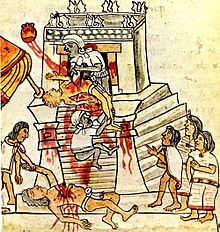Human sacrifice in Aztec culture
Appearance

The practice of human sacrifice featured heavily in the Aztec religion. When European explorers made contact with the Aztec culture, they wrote down detailed observations of the practices they witnessed. These accounts are also supported by archeological research.
Quotes
[edit]
- They lead him to the temple, where they dance and carry on joyously, and the man about to be sacrificed dances and carries on like the rest. At length the man who offers the sacrifice strips him naked, and leads him at once to the stairway of the tower where is the stone idol. Here they stretch him on his back, tying the hands to the sides and fastening the legs … Soon comes the sacrificing priest—and this is no small office among them—armed with a stone knife, which cuts like steel, and is as big as one of our large knives. He plunges the knife into the breast, opens it, and tears out the heart hot and palpitating. And this as quickly as one might cross himself. At this point the chief priest of the temple takes it, and anoints the mouth of the principal idol with the blood; then filling his hand with it he flings it towards the sun, or towards some star, if it be night. Then he anoints the mouths of all the other idols of wood and stone, and sprinkles blood on the cornice of the chapel of the principal idol. Afterwards they burn the heart, preserving the ashes as a great relic, and likewise they burn the body of the sacrifice, but these ashes are kept apart from those of the heart in a different vase.
- A companion of Hernán Cortés: Narrative of Some Things of New Spain and of the Great City of Temestitan, XV
- They have a most horrid and abominable custom which truly ought to be punished and which until now we have seen in no other part, and this is that, whenever they wish to ask something of the idols, in order that their plea may find more acceptance, they take many girls and boys and even adults, and in the presence of these idols they open their chests while they are still alive and take out their hearts and entrails and burn them before the idols, offering the smoke as sacrifice. Some of us have seen this, and they say it is the most terrible and frightful thing they have ever witnessed.
- Hernán Cortés: Cartas de relación, p. 26. México: Editorial Porrúa, 2005 translation.
- On these altars were idols with evil looking bodies, and that every night five Indians had been sacrificed before them; their chests had been cut open, and their arms and thighs had been cut off. The walls were covered with blood. We stood greatly amazed and gave the island the name isleta de Sacrificios [Islet of Sacrifices].
- Bernal Diaz: The Conquest of New Spain. Editorial Porrúa (2005 translation), p. 24.
- They strike open the wretched Indian's chest with flint knives and hastily tear out the palpitating heart which, with the blood, they present to the idols. … They cut off the arms, thighs and head, eating the arms and thighs at ceremonial banquets. The head they hang up on a beam, and the body is … given to the beasts of prey.
- Bernal Diaz: The Conquest of New Spain. Cited in "The Crimes of Christopher Columbus" by Dinesh D'Souza.
- Every day we saw sacrificed before us three, four or five Indians whose hearts were offered to the idols and their blood plastered on the walls, and their feet, arms and legs of the victims were cut off and eaten, just as in our country we eat beef bought from the butchers. I even believe that they sell it by retain in the tianguez as they call their markets.
- Bernal Diaz: The Conquest of New Spain, ch. XXXV
- When he reached said tower the Captain asked him why such deeds were committed there and the Indian answered that it was done as a kind of sacrifice and gave to understand that the victims were beheaded on the wide stone; that the blood was poured into the vase and that the heart was taken out of the breast and burnt and offered to the said idol. The fleshy parts of the arms and legs were cut off and eaten. This was done to the enemies with whom they were at war.
- Juan Díaz: Itinerario de Grijalva. Cited in "The Island of Sacrificios" by Zelia Nuttall, in American Anthropologist (1910), 12 (2): 257–295, doi:10.1525/aa.1910.12.2.02a00070.
- According to the accounts of some, they assembled the children whom they slew in the first month, buying them from their mothers. And they went on killing them in all the feasts which followed, until the rains really began. And thus they slew some on the first month, named Quauitleua; and some in the second, named Tlacaxipeualiztli; and some in the third, named Tocoztontli; and others in the fourth, named Ueitocoztli; so that until the rains began in abundance, in all the feasts they sacrificed children.
- The Florentine Codex, Book 2, ch. 4, folio 4v. Spanish-to-English Translation, Anderson & Dibble 1953–1982.

